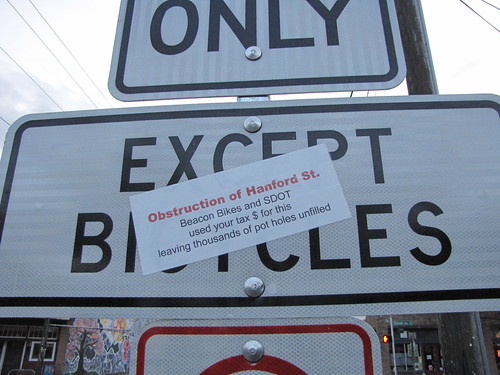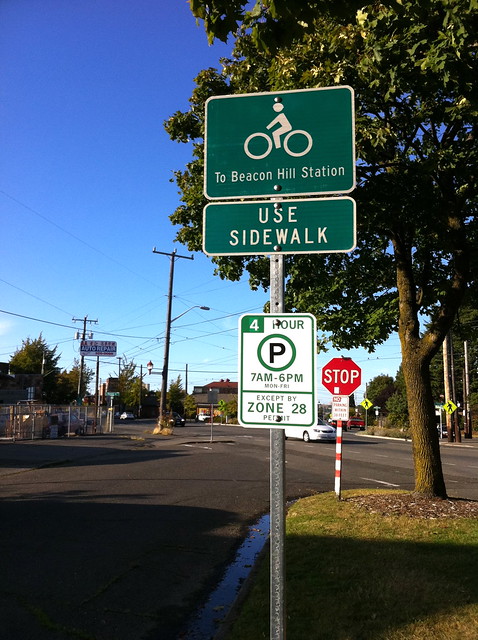
I drove the length of the Beacon Hill Neighborhood Greenway from the freeway to Jefferson Park on April 7. It was parallel to my usual route and I was curious. There were no bikes anywhere to be seen on the Greenway, but I did see two bicyclists pass northbound on Beacon Avenue when I was parked for a minute or two at South Hanford Street and Beacon Avenue South contemplating what to do about a traffic revision blocking my path. I could have chosen backing up a block and illegally around a corner to get back onto 18th, after discovering that anyone headed for Victrola on the opposite side of Beacon Avenue now needs to make a right turn, a U-turn, and another right turn to get across Beacon Avenue on Hanford Street. I’ll use my Fifth Amendment right to deflect any questions about which option I chose to find a route across the street.
The car counts and traffic history of the intersection at Beacon Avenue South and South Hanford Street prior to the recent “improvement” have been normally uneventful, and there is simply no reason for obstructing any normal vehicular access in any direction to continue safe bicycle use at that intersection. Yet we see a river of money being wasted there inconveniencing and endangering the high frequency of bicyclists using that intersection bound north-south on Beacon Avenue South, in favor of nearly mythical bicycle usage frequencies east-west on South Hanford Street.
The newly created islands at Beacon and Hanford are a hazard to bicycle traffic. They create a choke point in the north-south traffic flow on Beacon Avenue. There are north- and southbound bus stops in both curb lanes of Beacon Avenue South at South Hanford Street. The new concrete traffic islands squeeze all north- and southbound through traffic into a much narrower than usual lane width on either side of the concrete island. The new concrete islands block and occupy what used to be, and is everywhere else, the relatively traffic-free safe refuge area provided by a continuous two-way center left-turn lane. The hazard that represents to bicyclists on Beacon Avenue South should have been sufficient reason to prevent the islands from ever being built. But it did not. Now if we want to prevent inevitable injury at that intersection, we are faced with having to overcome the inertia of embarrassed SDOT engineers to remove the three recently built left-turn-lane-blocking islands there. I hope that public opinion will help that process move swiftly.
The needless disruption of normal turning movements of automobile traffic into and out of the neighborhoods east of Beacon Avenue South from and across Beacon Avenue, both westbound and eastbound, should motivate residents there to call for remedial action. When you consider that South Hanford Street is the only street connecting with Beacon Avenue South that goes east of 19th Ave S. between South Spokane Street and South Stevens Street, interfering with left turns southbound on Beacon Avenue South represents a very significant disruption of normal traffic in and out of a very large neighborhood area east of Beacon Avenue for hundreds of families every day. Rerouting daily east-west trips on South Hanford that would go left or cross Beacon Avenue, to South Stevens Street or onto the already overloaded Spokane Street unfairly burdens their neighbors living on the South Stevens Street route with the displaced traffic. The new median islands and traffic restrictions at Beacon Avenue South and South Hanford Street are, unsafe and are frankly ridiculous traffic engineering overkill. Bicycles and bicyclists as a special interest group do need to be accommodated, on every street, but not to the point of reckless endangerment and/or exclusion of other rightful users of the streets.
George Robertson is a Beacon Hill resident of more than twenty years, an architect, an artist, and an occasional writer of self-described “often-incendiary rants that annoy the neighbors.”
Do you have something to say? Send us your own opinion pieces on this or other Beacon Hill-related topics.






